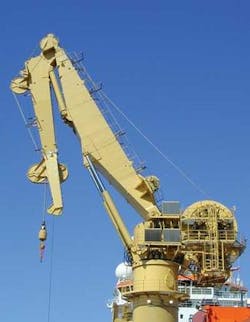National Oilwell Varco’s active heave compensation system can reduce downtime
Minimizing downtime is important in today’s offshore oil production arena, as companies are pressured to produce more oil to meet demand.
National Oilwell Varco’s (NOV) Hydralift active heave compensation (AHC) system reduces downtime from severe weather conditions, which, in turn, can help minimize subsea operations costs. The system is designed to compensate for actual wave height, thereby increasing the weather window for operations.
The AHC system is designed for subsea load handling from vessel or rig. Cranes and other handling systems with AHC can offer improved landing or lift-off even under adverse weather.
The system detects all vessel motions and loads, and automatically provides transitions to other modes, says NOV. Landing and lift off will occur at the most appropriate moment to prevent excessive tugging on the wire and lifting straps. It also helps prevents load collision with the seabed or other objects.
An AHC system keeps the load at a constant distance to the seabed regardless of the swell conditions acting upon the vessel. NOV’s Hydralift Intelligent Load Handling system allows the AHC to transition between various lifting modes either manually or automatically.
The Hydralift AHC system offers a compensation grade of approximately 97%. If the boom tip has a vertical motion of 3 m (10 ft), then the load would move 0.09 m (3.5 in.) relative to the sea bottom.
By using an accumulator pressure vessel (APV) system containing air or nitrogen to recover energy, requirement for power from the vessel is reduced by 75%.The Hydralift AHC systems focus on safety, and have been developed in compliance with applicable international rules and standards, says the company.
Modes
Normal mode is for normal crane operators, while AHC mode is a position controlled mode.
In AHC mode, the crane boom tip movement is calculated based on signals from a motion reference unit (MRU). These signals go to the control system that operates the winch cylinder to run in the opposite direction of the crane tip movement. The vertical mode can be used when the loads are intended to penetrate the seabed (such as suction anchors).
Constant tension (CT) mode is load controlled. The constant tension mode normally is used to control the tension in the wire rope when the load has landed. In CT mode, the system keeps tension in the wire rope at a preset value. The operator can select the transition mode from AHC to CT either manually or automatically. It normally takes place after the load is placed on the seabed.
In CT mode, the operator can also make the transition to AHC mode in order to release the hook from the load. The operator can lift the load from the seabed by gradually increasing the constant tension set point (smooth lift off) or by making a direct transition to Normal mode (fast lift off). CT mode also can gradually free loads from the suction of the seabed.
AHC Launch and Recovery System
NOV also supplies its Hydralift Launch and Recovery System (LARS) with active heave compensated system designed for handling of ROVs in all offshore conditions. LARS is fixed to a beam foundation ready to be welded or bolted to the deck.

